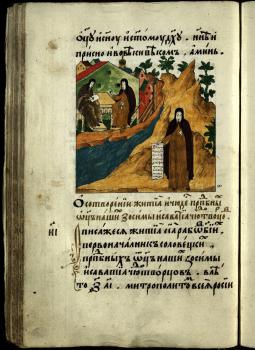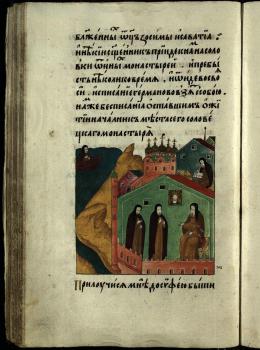Hegumen Dositheos
Dositheos, the follower of the Reverend Zosimus, was a head of the Solovetsky Monastery for a short time after the death of the saint. Dositheos gave the most significant impetus to the transformation of the monastery into a spiritual and cultural center. By order of the Archbishop of Novgorod Gennady, Dositheos compiled the first story of the lives of the St. Zosimus and Sabbatius of Solovki based on his own recollections of St. Zosimus and stories of the elder Herman about Sabbatius and St. Zosimus.
The work by Dositheos has survived in the edition of Metropolitan Spyridon-Sabbas who was engaged in literary work in exile in the Ferapontov Monastery. In the afterword titled Tale of the Creation of the Lives of the Heads of the Solovetsky Monastery, Dositheos told how he created the story of the lives of the saints. Only minor editorial changes were made to this text by Spiridon-Savva, which makes it possible to judge the writing style of Dositheus. He tells of events in the first person, includes autobiographical details, the narration is simple, without complicated sentences. The author’s version of the Tale is preserved in a book from the library of the Joseph Volokolamsk Monastery (РГБ, Волок. собр., No. 659). This manuscript includes two more stories, probably, written by Dositheos: St. Zosimus' Miracle with the Monk Deacon and the Prophecy of our Father St. Zosimus
In the Tale, Dositheos tells that he came to the Solovetsky Monastery during the life of St. Zosimus and heard many things directly from him, that he lived with Elder Herman in the same cell and read his memories which no longer in the monastery. The Tale testifies to Dositheos' trips on monastic affairs to Novgorod where he joined the literary circle established by Archbishop Gennady of Novgorod 1.
With Archbishop Gennady's blessing, Dositheos compiled the life story of the founders of Solovetsky Monastery. The author regarded himself as an artless narrator, so he asked Metropolitan Spyridon-Sabbas to edit the text when meeting the disfavoured hierarch in the Ferapontov Monastery on his way to Moscow.
Despite the extent of his literary abilities, evident in his surviving writings, Dositheos is known not as a writer, but as a book lover and collector. In the Solovetsky Monastery which was very remote from the cultural centers, he assembled a rich library containing most books circulated in Russia at that time, and many of them were for reading. The first inventory of the monastic property for 1514 2 proves that the necessary church service books in the monastery were also available. But Dositheos' book donations transformed the original monastic collection into a library with a very wide range of not only liturgical books, but also of the literature for reading. In Novgorod, Dositheos purposefully commissioned books for the Solovetsky Monastery. He carefully selected them, showing the breadth of interests and special love for each manuscript. Books made by order were labeled by him with a special handwritten mark – the ornate inscription "of Hieromonk Dosopheos" within the initial "С". This mark is considered to be the first bookplate in Russian books. In addition to the bookplate, some books contains prayers and records about donations to the Solovetsky Monastery, written, likely, by Dositheos himself. (ОР РНБ. Сол. 478/497, fol. 246v; Сол. 1049/1158, fol. 90v; Сол. 875/983, fol. 116). If these are Dositheos' autographs, then, according to the handwriting analysis 3, he should be recognized as the author of the famous entry titled the Testament Recollection of How Novgorod Citizens Traded, which is included in the Menaion to New Wonderworkers (ОР РНБ. Сол. 518/537, fol. 200v). Probably, Dositheos himself made a secret note with an encrypted name of the donor (decoding: Dositheos) in the Festive Collections of Readings (rus. Torzhestvennik prazdnichnyj), which does not contain Dositheos' bookplate (ОР РНБ. Сол. Анз. 62/1428, fol. 332).
For the history of the Solovetsky Library, two records are of particular importance. They contain large lists of books commissioned by Dositheos in Novgorod for the Solovetsky Monastery. The first list of 1493 is read in the Book of the Pilot (rus. Kórmchaia Book) (ОР РНБ. Сол. 868/968, fol. 609v) and includes 17 books that Dositheos already sent to the monastery. The second list of 1494 is written in the Typikon (rus. Ustav) (ОР РНБ. Сол. 1128/1237, fols. 140v-141) and includes the same 17 manuscripts and 7 more books, three of which were also sent to the Solovetsky Monastery, and four were just ordered. The most complete list of Dositheos' manuscripts, including 42 books with their titles, is given in the property inventory for 1514 4. These three sources are important for identifying the books belonging to Dositheus within the Solovetsky Library. In total, there are 21 manuscripts with Dositheos' bookplate and 2 more books that do not contain his ex-libris, but are precisely attributed to Dositheos from all evidence. Another manuscript with his bookplate is now in the Russian State Library (РГБ, собр. Овчинникова (ф. 209), No. 791). Thus, 24 surviving manuscripts are known, undoubtedly belonging to Dositheus.
The summary table shows the modern shelfmarks of those Dositheos' books that can be identified by title with those mentioned in the lists (the "+" sign indicates the presence of a book in the corresponding list):
| Book Title | List of 1493: Books of the Pilot (Kórmchaia Book) Сол. 858/968 |
List of 1494: Typikon (Ustav) Сол. 1128/1237 |
List of 1514. Inventory | Manuscript Shelfmark |
| Books of the Pilot (Kormchej dusham) | + | + | + | РНБ, Сол. 858/968 |
| Typikon (Ustav Oko tserkovnoe) | + | + | РНБ, Сол. 1128/1237 | |
| Quotes by St. John Chrysostom (Margarit) | + | + | + | РНБ, Сол. 491/510 |
| Cosmas the Priest (Koz'ma Prozviter) | + | + | + | РНБ, Сол. 856/966 |
| John the Exarch (Ioann Ekzarh) | + | + | + | РНБ, Сол. 318/338 |
| Dionysius the Areopagite (Dionisij Areopagit) | + | + | + | РНБ, Сол. 115/115 |
| Prophecies (Prorochestva) | + | + | + | РНБ, Сол. 694/802 |
| Cyril of Jerusalem (Kirill Ierusalimskij) | + | + | + | РНБ, Сол. 478/497 |
| Hexameron of St. Basil the Great (Shestodnev Vasilyev) | + | + | + | РНБ, Сол. 873/983 |
| Lenten Collections of Readings (Torzhestvennik postnyj chetij) | + | + | + | РНБ, Сол.Анз.62/14285 |
| Apocalypse of John the Apostle (Apokalipsis Ioanna Bogoslova) | + | + | + | РНБ, Сол. 1049/1158 |
| Life of John Chrysostom (Kniga Zhitie Ioanna Zlatousta) | + | + | РНБ, Сол. 199/199 | |
| Athanasius of Jerusalem (Afanasij Ierusalimskij) (of Alexandria –Inventory for 1514) | + | + | РГБ, собр. Овчинникова (ф. 209), № 791 | |
| Andrew the Fool-for-Christ (Andrej Jurodivyj) | + | + | РНБ, Сол. 216/216 | |
| Menaion to New Wonderworkers (Mineja novym chudotvorcam) ("ka-nuny da zhitija s'brano") | + | + | РНБ, Сол. 518/5376 | |
| Psalter (Psaltyr' v dest'/ "narjadil") | + | РНБ, Сол. 754/864 | ||
| Festive Collections of Readings (Torzhestvennik prazdnichnyj) | + | РНБ, Сол.Анз.83/1448 | ||
| Explanatory Psalter (Psaltyr' tolkovaja) | + | РНБ, Сол. 1044/1153 |
The table shows that only 18 of the 24 Dositheos' manuscripts mentioned in the documents. Other 6 manuscripts with Dositheos' bookplate doesn't appear in any source written during his lifetime: ОР РНБ. Сол. 27/27; Сол. 75/75; Сол. 258/258; Сол. 1024/1133; Сол. 1056/1165; Сол. 802/912. This circumstance can be explained only by the fact that in 1514, when the inventory of the monastic property was compiled, the owner had these books in the personal use in his cell. In the inventory for 1514, Dositheos is identified as a former Hegumen and ranks first among best elders, in charge of keeping inventory. This is the last document containing the news of Dositheos alive.
Our resource presents 23 manuscripts from the Solovetsky Collection of the National Library of Russia, which belonging to Dositheus is not questioned. It is likely that other Dositheos' books have survived to this day in the Solovetsky Library or in other manuscript collections, including private ones. However, their identification requires a complex of data and cannot be based only on similar titles of manuscripts and close dates of their creation.

